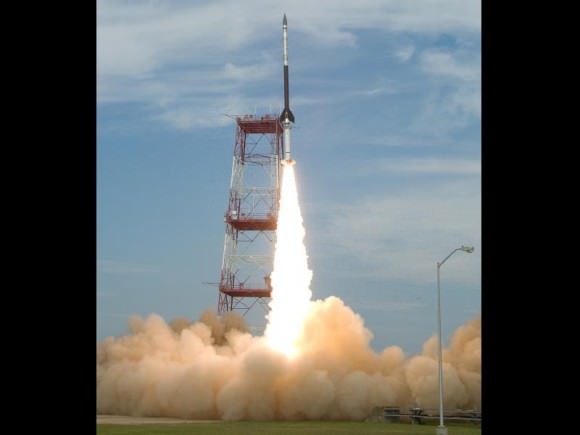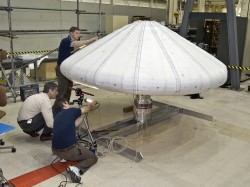[/caption]
NASA conducted a successful test Monday morning of a new type of heat shield that could make it possible to land larger payloads on Mars. The Inflatable Re-entry Vehicle Experiment (IRVE) demonstrated an inflatable heat shield which could slow and protect spacecraft entering atmospheres at hypersonic speeds. “This was a small-scale demonstrator,” said Mary Beth Wusk, IRVE project manager, based at Langley Research Center. “Now that we’ve proven the concept, we’d like to build more advanced aeroshells capable of handling higher heat rates.”

IRVE was vacuum-packed into a 38 cm (15-inch) diameter payload shroud and launched with a Black Brant 9 sounding rocket from NASA’s Wallops Flight Facility on Wallops Island, Va., at 8:52 a.m. EDT. The 3 meter (10-foot) diameter heat shield, made of several layers of silicone-coated industrial fabric, inflated with nitrogen to a mushroom shape in space several minutes after liftoff.
At four minutes into the flight, the rocket reached 210 km (131 miles), and deployed the heat shield, which took less than 90 seconds to inflate. According to the cameras and sensors on board, which relayed real-time data back to engineers on the ground, the heat shield expanded to its full size and went into a high-speed free fall. The key focus of the research came about six and a half minutes into the flight, at an altitude of about 50 miles, when the aeroshell re-entered Earth’s atmosphere and experienced its peak heating and pressure measurements for a period of about 30 seconds.
“Our inflation system, which is essentially a glorified scuba tank, worked flawlessly and so did the flexible aeroshell,” said Neil Cheatwood, IRVE principal investigator and chief scientist for the Hypersonics Project at NASA’s Langley Research Center in Hampton, Va. “We’re really excited today because this is the first time anyone has successfully flown an inflatable reentry vehicle.”

Inflatable heat shields hold promise for future planetary missions, according to researchers. To land more mass on Mars at higher surface elevations, for instance, mission planners need to maximize the drag area of the entry system. The larger the diameter of the aeroshell, the bigger the payload can be.
For more information on the problems of landing on Mars, and other inflatable heat shields and supersonic decelerators that are being developed, check out our previous article with Rob Manning of JPL and Glen Brown of Vertigo, Inc.
Sources: NASA, NASA

Yay! There remains scaling issues (a priori severe, it looks like :-/) and in situ test, but at least it passed a sanity test.
Also, can’t refrain from noticing the man scale. With any luck, the space tourist business have a future income source. Think of all adrenaline junkies that will have to try aeroshell reentrance + parachute landing from tomorrows suborbital and orbital vehicles! On their own risk, too. (o.O)
Provided they put in the needed air locks in later designs of course.